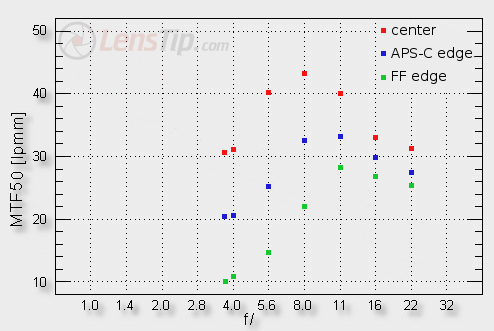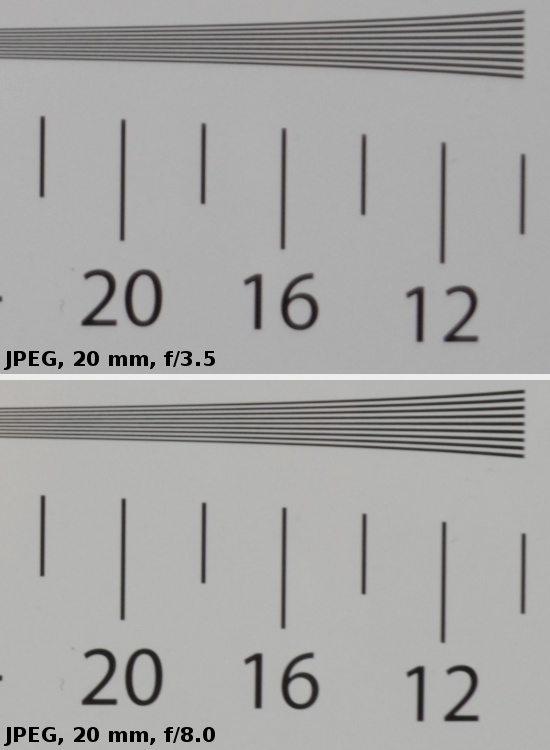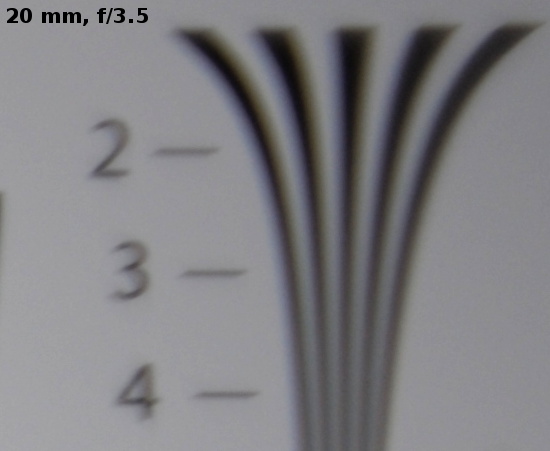Voigtlander Color Skopar 20 mm f/3.5 SL II Aspherical
4. Image resolution

Let’s deal with the frame centre performance first. Near the maximum relative aperture, so by f/3.5 and f/4.0, the lens has results a bit above 30 lpmm, exceeding slightly the decency level which, in the case of tests performed on the Nikon D3x, is positioned mear 30 lpmm. It would be difficult to criticize the tested lens here but, remembering its rather average fastness, we would like to see a bit better results. Actually better results are obtained but only on further stopping down of the aperture. By f/5.6 we see very good achievements because MTF50 function values, measured by us, reach even 40 lpmm there and by f/8.0 –almost 44 lpmm. The lens should be praised for the performance although it doesn’t break any resolution records. You must be sensible, after all – demanding records from such an untypical lens would be rather foolish.
Please Support UsIf you enjoy our reviews and articles, and you want us to continue our work please, support our website by donating through PayPal. The funds are going to be used for paying our editorial team, renting servers, and equipping our testing studio; only that way we will be able to continue providing you interesting content for free. |
- - - - - - - - - - - - - - - - - - - - - - - - - - - - - - - - - - - - - - - - - - - - - - - -
Other apertures show resolution decrease due to an influence of diffraction. The interesting thing is that the results by f/16 and by f/22 are noticeably higher than those of other lenses of this class. Such an effect doesn’t depend on the optics but rather on the mechanics of the aperture. By f/22 and 20 mm focal length it’s only 0.9 mm in diameter. Even slight inaccuracies in its build or stopping down, reaching just 0.1 mm or so, might cause the actual value of the aperture amounting to e.g. rather f/20 than f/22; as a result the lens will be less limited by the diffraction and will reach a bit better resolution level.
Let’s see how the lens fares on the edge of an APS-C/DX sensor. The situation is not optimistic. At the maximum relative aperture the lens slightly exceeds the level of 20 lpmm and it reaches the decency level only near f/7.1 aperture. If you want to enjoy fully sharp images you must stop the Voigtlander down to the range of f/8.0 – f/16.
The edge of a very demanding full frame sensor, packed with as many as 24 million pixels, simply knocks the tested lens out. Its results are record-low here and near the maximum relative aperture they reach only 10 lpmm.
Does it surprise us? To tell you the truth, hardly. This lens is one big compromise incarnate. After all a complex optical system, with plenty of elements, can’t fit into a small barrel. With such a wide angle of view the correction of such aberrations as coma, astigmatism or field curvature is very difficult. In the following chapters we will find out the real extent of the damage in this case. There are also other problems. Small elements (let’s remind here that the rear element is only 1 cm in diameter) have to cast the image on a big full frame sensor – the problems with vignetting and telecentricity are practically guaranteed.
The combination of astigmatism, coma, vignetting, field curvature, chromatic aberration and diffraction makes the edge of this lens’s field of view looking like that – simply dismal, not even reaching full usefulness by any aperture, only brushing against it near f/11.
It’s also worth noticing that the lens, because of its short focal length, was tested on our biggest resolution test charts. The third biggest chart was too small to take any quality measurements. The results we obtained on the bigger chart, for which the lens was positioned a bit further from the aim, were slightly better than those on the smaller chart. It suggest that if you take a picture from greater distance, for instance a landscape or architecture photo, the results might be a bit better, than those showed on the graphs above and in the crops below.
At the end we present our test chart crops of JPEG files, saved along RAW files in the camera. The crops taken near the frame centre by f/3.5 and f/8.0 we show as the first ones and at the bottom there is a crop from the top right-hand corner of the photo taken by f/3.5.
 |
 |






